Unearthed on June 22, 1911, the hoard consisted of 6 kilos of uncoined cut-silver bullion and c. 4.2 kilos of silver coins, c. 600 coins in all. Fully four-fifths of the latter are South Italian (Metapontum, Sybaris, Croton, Velia, and Posidonia,; the remaining 121 coins came from Corcyra and 23 cities in Sicily, Thrace, Central Greece, and some Aegean islands. E. Babelon (RN 1912, 1-40) promptly published a nearly complete record of the coins together with notes on some of the unminted silver, including the end of a flat rectangular slab ingot that had been stamped with a square incuse stamp identical to those on the reverses of coins of Selinus. Close to half of the uncoined silver, including the stamped slab ingot fragment, however, has not been seen since M.P. Vlasto initially recorded the hoard in Paris and Taranto in 1911; it is assumed that this silver was lost to the melting pot.
On October 14, 1921, The British Museum Department of Coins and Metals purchased from Spinks the other half of the bullion, some 60 pieces of ingots and of worked silver with a total weight of just over 3 kilograms, in a sizable hoard lot that also included 47 coins of Metapontum, Sybaris, and Croton, most of them in chipped, broken, or extremely fragmentary condition. Although the lot includes the largest preserved assemblage of silver bullion from the ancient Greek world, it has remained unstudied and unpublished.
The decision to make this material available on the Internet was initially motivated by the unlikelihood that any journal would be interested in publishing a fully-illustrated record of these less than aesthetically pleasing chunks of metal. Internet-based publication offers its own advantages, however, and a brief discussion of these may improve the readers ability to make use of the information presented here.
In the preparation of this publication an important distinction was made between the permanent archival version of the document and the presentation of that information in an easily readable form. Hypertext Markup Language (HTML) is the formatting language of the World Wide-Web and has proven to be an immensely successful means of delivering digital content to wide audiences. Its main disadvantage, however, it is that it tends to strip documents of any information not related to their appearance on a computer screen. The formal specification of HTML is also rapidly changing and there is no guarantee that it will not be entirely superceded at some future point. This could result in HTML documents no longer being easily readable by standard applications.
In order to overcome these shortcomings of HTML, this publication uses the Extensible Markup Language (XML) as the format for its long-term, archival version. XML is an internationally recognized standard for representing the structure of documents and is easily transformed into either HTML or plain text for internet-based reading. This flexibility allows multiple versions of this document to be made available. Accordingly, it is possible to view the list of ingots, rods, and coins either with or without images directly attached. Furthermore, the list of objects have also been sorted by type then weight, as well as by weight then type.
These brief comments are not intended as full introduction to the current state-of-the-art in digital publication of scholarly materials. Further information about XML is available at the web site of the World Wide Web Consortium. The specific tag set used by this document was developed by the Text Encoding Initiative (TEI).
As of the time of publication there is no formal standard for resolution-independent rendering of images within web-browsers. It is therefore not possible to ensure that images appear at 1:1 on reader's computer screens or on paper after printing. The resolution of the inline images that appear in the third version of this document is 60 dpi, and 150 dpi for those linked-to from the second version. The authors hope that the inclusion of scales under all images partially alleviates this problem.
Ingot types
| F | = Flat ingot (thickness relatively even), either rectangular or circular (pancake-like) i shape. |
| FR | = Flat rectangular slab ingot (thickness relatively even). |
| Cake | = Cake ingot: disk-shaped, plano-convex in section. |
| Bar | = Rectangular bar ingot, plano-convex in section. |
| No. | B.M. Acc. | Weight | L. (mm) | W. (mm) | Th. (mm) | Ingot Type | Description | |
|---|---|---|---|---|---|---|---|---|
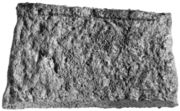

|
1. | 1921,1014.185 | 559.9 | 110 | 66 | 8-12 | FR | 4 edges: the 2 long ones cut, the two short ones original as cast. |
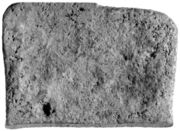
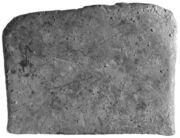
|
2. | 1921,1014.186 | 429.3 | 96 | 74 | 7 | FR | Slab end: 1 edge cut, 3 original edges as cast. Rough surface deeply punched with with a circular stamp(?), possibly bearing the letter Α or Δ (as recorded in the BM inventory), if in fact there is any letter in relief at all. |
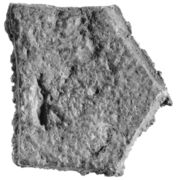
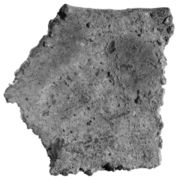
|
3. | 1921,1014.187 | 181.4 | 54 | 53 | 10 | FR | 5 edges, of which 4 are cut. |


|
4. | 1921,1014.188 | 129.6 | 59 | 32 | 10 | Cake | 5 edges, of which 2 1/2 are cut. 2 incuse punches on smooth face. |


|
5. | 1921,1014.189 | 99.5 | 66 | 25 | 8 | FR | 4 edges, of which 3 are cut. |

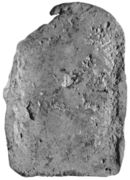
|
6. | 1921,1014.190 | 114.7 | 58 | 42 | 8 | Cake? | 4 edges, of which 3 cut. Circular depression (from a stamp?) on the face cut across with a chisel. |
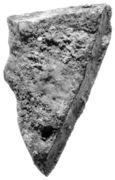
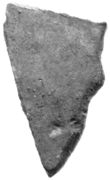
|
7. | 1921,1014.191 | 87.5 | 62 | 32 | 9 | F | 3 edges, of which 2 cut; one (curved) as cast. |

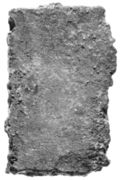
|
8. | 1921,1014.192 | 105.8 | 44 | 28 | 12 | F | 4 cut edges. |
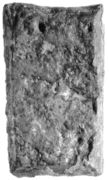
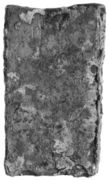
|
9. | 1921,1014.193 | 80.8 | 51 | 30 | 7 | F | 4 cut edges. |

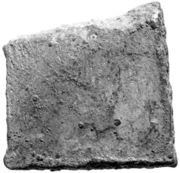
|
10. | 1921,1014.194 | 168.0 | 42 | 43 | 8 | F | 4 edges, of which 3 are cut. |


|
11. | 1921,1014.195 | 103.7 | 62 | 35 | 14 | Bar | 3 edges, of which 2 cut. |
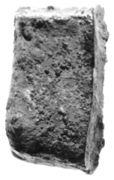
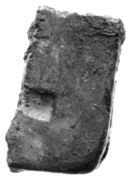
|
12. | 1921,1014.196 | 136.7 | 45 | 26 | 18 | FR | Corner of thick slab: 4 edges, of which 2 are cut. Deep squarish punch on the smooth surface. |
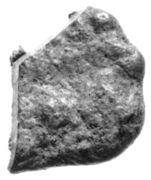

|
13. | 1921,1014.197 | 66.1 | 38 | 46 | 7 | FR | Corner piece, of which 2 edges are cut. |
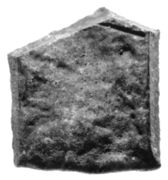

|
14. | 1921,1014.198 | 53.1 | 37 | 32 | 7 | FR | 5 edges, of which 4 cut. |


|
15. | 1921,1014.199 | 41.1 | 56 | 25 | 7 | FR | Corner piece, of which 1 edge is cut. |


|
16. | 1921,1014.200 | 53.3 | 49 | 29 | 15 | Bar | 3 edges: one original as cast, two cut with a curved chisel blade. |


|
17. | 1921,1014.201 | 44.7 | 42 | 29 | 8 | FR | 4 edges, of which 3 are cut. |
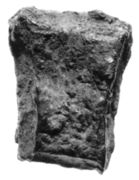
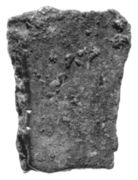
|
18. | 1921,1014.202 | 38.8 | 32 | 24 | 10 | F | 4 cut edges. |
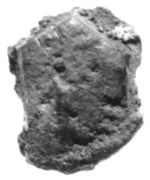
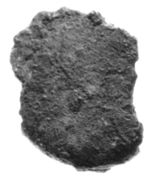
|
19. | 1921,1014.203 | 33.4 | 32 | 24 | 8 | Cake | 5 edges, of which 4 are cut. |


|
20. | 1921,1014.204 | 52.2 | 42 | 18 | 11 | FS | Corner piece, of which 2 edges are cut. |


|
21. | 1921,1014.205 | 38.9 | 58 | 15 | 6 | F | 4 cut edges. |


|
22. | 1921,1014.206 | 36.6 | 42 | 14 | 8 | Bar | Middle section, of which the 2 long edges are cut, the two short edges are original as cast. |

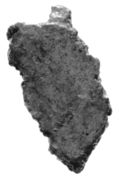
|
23. | 1921,1014.207 | 39.5 | 42 | 21 | 7 | F | 4 cut edges. |
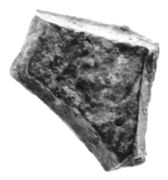
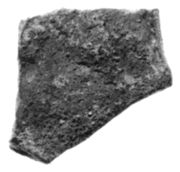
|
24. | 1921,1014.208 | 37.3 | 25 | 26 | 10 | Bar | 4 edges, of which 3 are cut. |
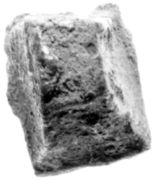

|
25. | 1921,1014.209 | 23.1 | 20 | 15 | 19 | ? | 4 edges of thick ingot cut into truncated pyramid shape . |
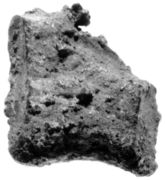
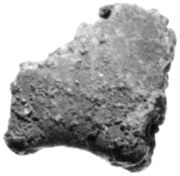
|
26. | 1921,1014.210 | 36.3 | 27 | 25 | 10 | FS | 5 cut edges. |
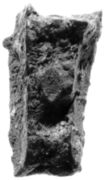

|
27. | 1921,1014.211 | 21.4 | 27 | 16 | 10 | Bar? | 4 edges, of which 3 are cut. |
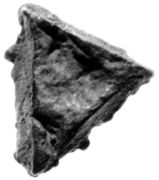
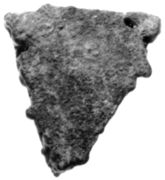
|
28. | 1921,1014.212 | 18.1 | 26 | 24 | 8 | F | 3 cut edges. |
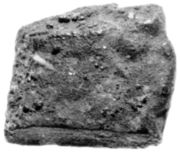
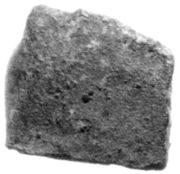
|
29. | 1921,1014.213 | 12.6 | 20 | 17 | 5 | FS | 4 edges, of which 3 are cut. |


|
30. | 1921,1014.214 | 18.5 | 27 | 13 | 14 | ? | 4 cut edges. |

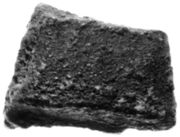
|
31. | 1921,1014.215 | 34.0 | 26 | 19 | 14 | FS | 4 edges, of which the longest (with a moulded, offset profile) is original as cast . |

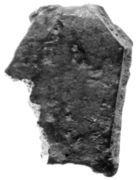
|
32. | 1921,1014.216 | 29.9 | 37 | 26 | 7 | F | 5 edges, of which 2 are original, 3 are cut, and one is roughly torn off. |

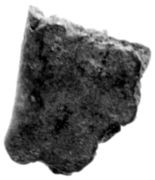
|
33. | 1921,1014.217 | 15.4 | 21 | 18 | 7 | FR | 5 sides. of which 3 are cut. |
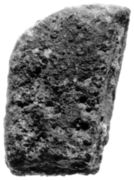
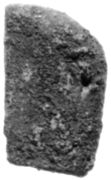
|
34. | 1921,1014.218 | 18.3 | 29 | 16 | 6 | FR | Corner piece, of which 2 edges are cut. |


|
35. | 1921,1014.219 | 22.5 | 38 | 18 | 5 | Bar Dump | Whole. Chisel cut across middle. |

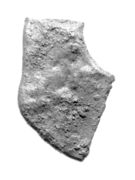
|
36. | 1921,1014.220 | 14.3 | 32 | 20 | 5 | F | Corner piece, of which 2 edges are original, 3 are cut. |
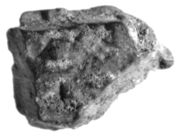

|
37. | 1921,1014.221 | 17.2 | 24 | 19 | 6-8 | Cake or Bar | 5 cut edges. Lines from possible grafitto on one face. |

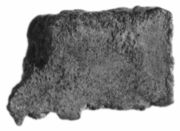
|
38. | 1921,1014.222 | 14.3 | 22 | 14 | 8 | F | 4 cut edges. |
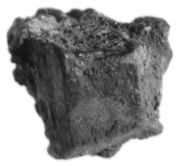
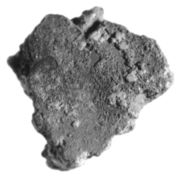
|
39. | 1921,1014.223 | 21.8 | 21 | 20 | 8-13 | Cake or Bar | 4 cut edges. |

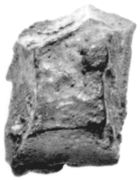
|
40. | 1921,1014.224 | 18.5 | 23 | 16 | 8-10 | Cake or Bar | 4 cut edges. |

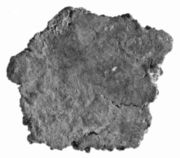
|
41. | 1921,1014.225 | 19.0 | 28 | 24 | 5 | F | 5 cut edges. |

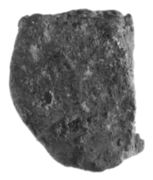
|
42. | 1921,1014.226 | 11.0 | 21 | 16 | 7 | F | 5 edges, of which 4 are cut. |
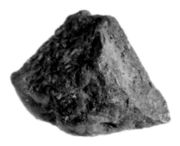
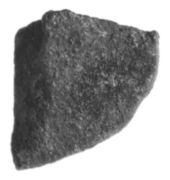
|
43. | 1921,1014.227 | 10.0 | 21 | 16 | 10 | Cake | 3 edges, of which 2 are cut . |
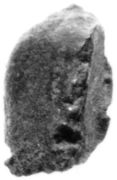
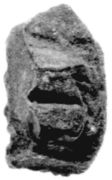
|
44. | 1921,1014.228 | 11.8 | 21 | 31 | 10 | ? | 4 edges, of which 3 are cut; original cast edge is slightly curve with a moulded, offset profile. |
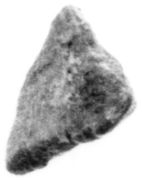

|
45. | 1921,1014.229 | 3.9 | 15 | 16 | 7 | ? | 4 cut facets. |
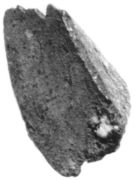

|
46. | 1921,1014.230 | 17.9 | 26 | 15 | 15 | Cake | 3 cut edges, from center of ingot. |
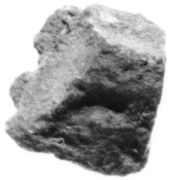
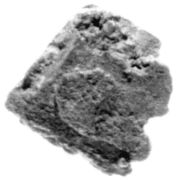
|
47. | 1921,1014.231 | 7.8 | 16 | 14 | 7 | ? | 4 edges, of which 3 are cut . |
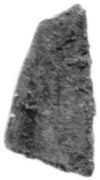

|
48. | 1921,1014.232 | 4.3 | 19 | 9 | 7 | F | 4 edges, of which 3 are cut. |


|
49. | 1921,1014.233 | 4.3 | 18 | 8 | 5 | ? | 4 edges, of which 3 are cut. |
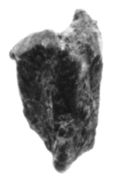

|
50. | 1921,1014.234 | 5.1 | 17 | 11 | 10 | FR | 4 edges, of which 3 are cut. |

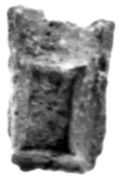
|
51. | 1921,1014.235 | 4.4 | 14 | 9 | 7 | ? | 4 cut edges in truncated pyramid shape. |
| No. | B.M. Acc. | Weight | L. (mm) | W. (mm) | Th. (mm) | Ingot Type | Description | |
|---|---|---|---|---|---|---|---|---|
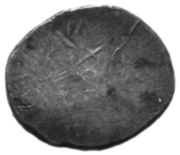
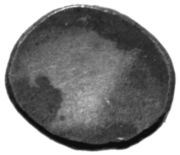
|
52. | 4.32 | 20 | 17 | 3 | Worked Silver | Flattened disk. | |
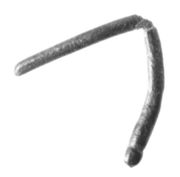
|
53. | 1921,1014.241 | 1.04 | 17 | 18 | 2 | Worked Silver | Thin rod, scored and bent in middle; scored also 2mm from one end. |
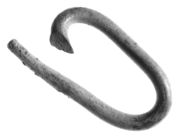
|
54. | 1921,1014.242 | 40.10 | 63 | 31 | 4-7 | Worked Silver | Thick tapering rod, bent back twice on itself. |

|
55. | 1921,1014.243 | 32.0 | 55 | 21 | 2-11 | Worked Silver | Thick, uneven rod bent and twisted. |

|
56. | 1921,1014.244 | 10.2 | 46 | 20 | 2-5 | Worked Silver | Thick tapering rod bent in two. |

|
57. | 1921,1014.245 | 2.78 | 51 | 8 | 0.7 | Worked Silver | Thin flat strip, now broken in 4 pieces. |
| No. | B.M. Acc. | Weight | L. (mm) | W. (mm) | Ingot Type | Description | |
|---|---|---|---|---|---|---|---|

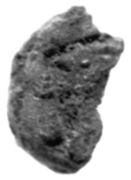
|
58. | 1921,1014.236 | 3.24 | 15 | 8 | Coin | Frag. of disfigured coin. |
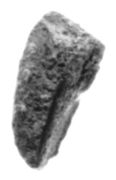

|
59. | 1921,1014.237 | 3.88 | 16 | 10 | Coin | Chopped frag. of Macedonian tribal coin: "Lete" (Standing satyr and nymph/incuse square). |
| 60. | 1921,1014.238 | 4.31 | 21 | 21 | Coin | Chopped coin frag. of Naxos (Kantharos/incuse square) Not illustrated. |
|
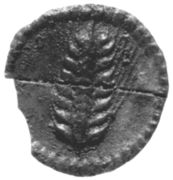
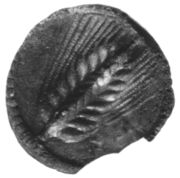
|
61. | 1921,1014.249 | 8.02 | 29 | 28 | Coin | Wide-flan, incuse stater of Metapontum. Intentionally scored or chisel-cut across the obverse. |
Not Illustrated
| 1921,1014.246 - 248, 250 - 260, 269 - 278, 292, 293 | 26 other wide-flan, incuse staters of Metapontum (type: ear of barley ), nearly all chipped or broken in two or more fragments |
| 1921,1014.239, 261 - 268, 279 - 287, 290, 291 | 18 staters and 2 drachms of wide-flan, incuse coinage of Sybaris (type: standing bull); nearly all chipped at the edges or broken in two or more fragments |
| 1921,1014.288, 289 | 2 wide-flan, incuse staters of Croton (type: tripod), both chipped |